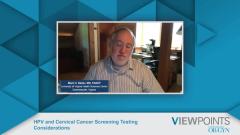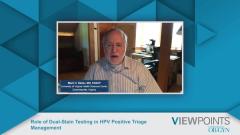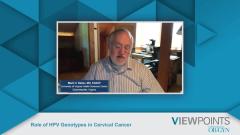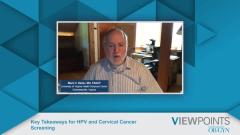
Role of Dual Testing in HPV Positive Triage Management
Mark H. Stoler, MD, FASCP, provides insight on the role of dual testing in the management of HPV positive women.
Episodes in this series

Dr Thomas C Wright Jr: As we move to HPV primary screening, the big issue is going to be triage of HPV-positive women. Currently, when we cotest, we use cytology as a triage. If you've got an abnormal cytology, you're managed differently than if you have a negative cytology, depending on whether or not you've got HPV 16 or 18. There are other triage methods which are currently available and under development. One of those is CINtec PLUS which is testing for p16 and Ki-67. P16 is a small molecular way marker for cell cycle progression as is Ki-67. Normal cells will not coexpress p16 and Ki-67 whereas neoplastic cells do. We can use that for cytology as a way of determining whether or not there is a CIN really present or not. Dr Stoler, you were involved in a large study which got FDA approval of CINtec. Can you talk about that?
Dr Mark H Stoler: The IMPACT trial which led to the FDA approval as well as data retrospectively that you and I have published from the ATHENA study basically looked in the primary HPV screening algorithm at the performance of triage test. Either cytology is a triage at various cut points, ASCUS [squamous cells of undetermined significance] or above, LSIL [low-grade squamous intraepithelial lesion] or above vs dual stain cytology which is performed on the same kind of liquid-based cytology slide but is an immunohistochemical test. What we found in those studies repeatedly is that CINtec PLUS or p16 and Ki-67 dual stain as a scientific name for the procedure outperformed cytology by a significant fraction. Remarkably, it does something that's very rare in laboratory testing. It was 25% to 30% more sensitive meaning it found the CIN 3 in the HPV positive population or the precancers of the HPV positive population more effectively than cytology even at the lowest threshold of cytologic abnormality; it was simultaneously more specific at least in some of the analyses. You had the best of both worlds in terms of triage and the implication of these studies and why it was FDA approved is that in a primary screening algorithm you greatly improved the safety and efficacy of the triage procedure. You get the right patients to go to colposcopy and you don't colposcope or biopsy nearly as many women as you would with a cytology test as triage.
TRANSCRIPT EDITED FOR CLARITY
Newsletter
Get the latest clinical updates, case studies, and expert commentary in obstetric and gynecologic care. Sign up now to stay informed.













